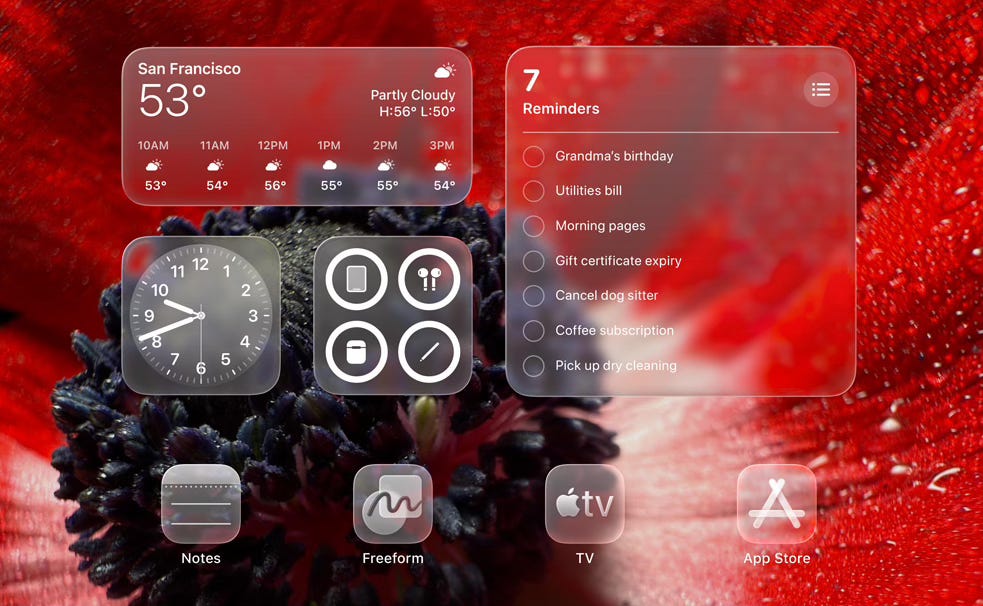If you’ve been following all the Apple buzz the last couple weeks you’ll be aware that Apple’s annual Worldwide Developer’s Conference (WWDC) just happened. Over the years, what used to be a closed technical conclave of Apple geeks has become a public media event that shares Apple’s plans for next year’s software, which, like new cars, releases to the public every Fall.
The WWDC Keynote happened on June 9th with sneak peeks into the new features and design of Apple’s suite of devices operating systems - iOS for iPhone, iPadOS for iPad, watchOS for Apple Watch, visionOS for Vision Pro, and macOS for Macs. As part of the event, the developers get to download beta versions of the software to test with their applications.
So June is always an exciting time for Apple users too with the promise of interesting new features and the general buzz around Apple technology that comes with it. YouTube reviews, newsletter posts, and social media will pick apart and showcase every new aspect of the upgrades for weeks. Most of us will watch with curiosity from the sidelines but some of us can’t wait to get their hands on it.
It’s to those people that I speak.
On Tuesday the 10th - less than 24 hours after the announcements, mind you, I already saw social media posts complaining about how the software trashed someone’s iPhone with vibrations they can’t turn off.
Uh, huh.
These Operating Systems are monstrously complex. By some estimates, the macOS has over 80 million lines of code that control the whole user experience. Whenever you click a mouse or enlarge a window, your action is interpreted by some line of code that delivers the result. So every year when Apple updates their Operating System, the developers who make apps that run on it have to update their code as well. Both to ensure their software works properly with the new OS, and to be sure their software doesn’t break the new OS.
The way this works is that software goes through testing phases to fine tune new features and identify performance issues.
Alpha phase is the original closed portion that is only available to the developer themselves as they flesh out the software and make it work to the best of their resources. Once they are pretty happy with the software, they will enlist a wider group of outside “beta” testers to try out the software in the real world where it has to play nicely with other apps and devices. These beta testers may be developers in their own right or tech geeks who like the challenge of helping make a new app workable and secure.
Based on feedback from the beta testers the developer will make changes and release new beta versions of the software until all the reported issues have been resolved and the software is deemed ready for public release as an actual, certified product.
Even then, though, there are bound to be untested combinations of software & hardware that the beta testers missed. So when the software is released to the public for wide use, some additional glitches usually show up. Most often the nuisance kind, not serious, but they have to be fixed as well. Which is why for major upgrades, waiting a couple weeks for the 1st or 2nd update after public launch isn’t a bad idea.
Here’s the thing.
Beta testing used to be more tightly vetted than it is now. The beta testers had to sign acknowledgements that the software could cause problems. Even loss of data. Not only that, but now some developers - Apple does this - offer a public beta version during development. Giving anyone the chance to play with the new, pre-release versions of the software. So it’s not that hard to get either the developer’s beta or a public one before the official release.
This all means that tech enthusiasts, teenage boys, and even unsuspecting amateurs can install beta software on their devices with unpredictable results. Apps can crash. Data can disappear. Performance can suffer. Probably not, but it can.
If you or someone you know is considering an install of beta software, be sure you REALLY understand the risks. For most of us, getting early access to that cool new feature isn’t worth the chance that your favorite app won’t work or your device becomes glitchy.
If you _are_ irresistibly intrigued, follow the rules of common sense.
• Never install beta software on your primary device - the one that you need every day to function properly.
• Create a full backup of your device before installing beta software
• Turn off the auto update for beta installs so you can control the process at your own pace
Most of all, if you take on the task of running beta software, be a player and report any glitches to the developers. That’s the whole point of beta releases, after all, to make the software rock solid and reliable by testing it with real people in real situations that the developers might never duplicate. You’ll find a feedback link to the developers, be it Apple or a 3rd party, usually in the Help Menu. They are eager for your comments.
Software is always evolving, particularly at the level of operating systems, and beta testing is one of the ways that developers can quickly improve user experience and discover bugs. It’s fun to be a part of that and be at the leading edge of new features. But that comes with risks and responsibilities that most of us don’t want to deal with.
So if someone suggests you install beta software to get access to some cool new feature or user experience, weigh it against those risks. Public beta software is typically more tested and reliable than developer beta releases, but neither one beats the official public version that’s been crash tested, fixed, and released into the world.










Great article, Paul.